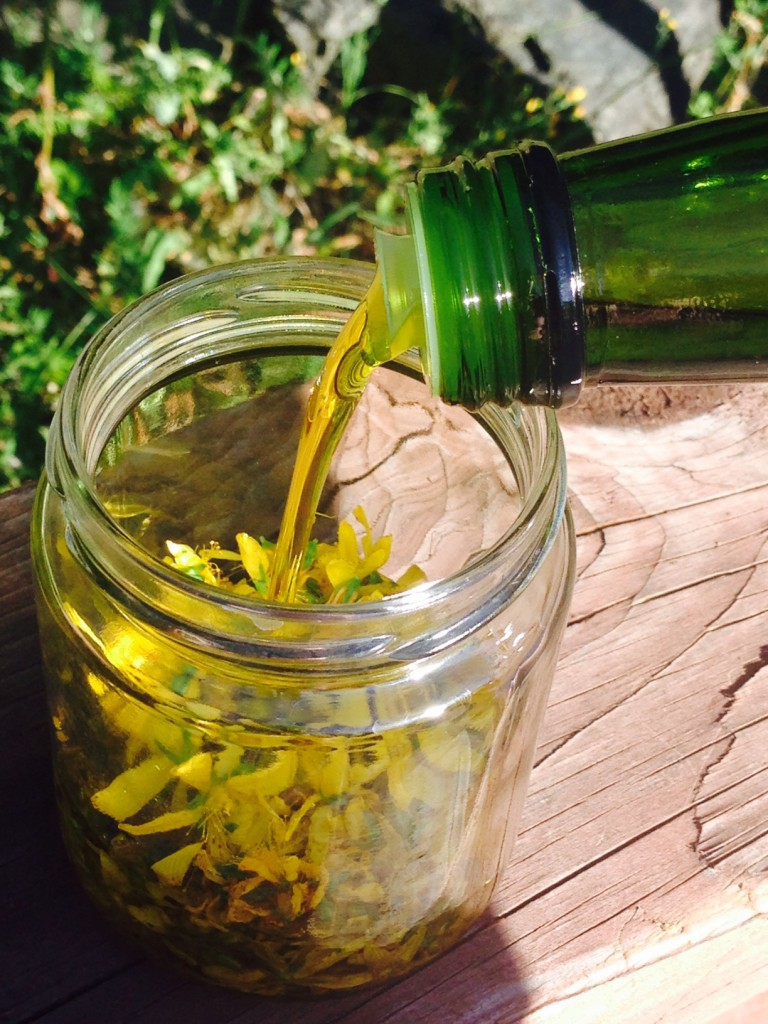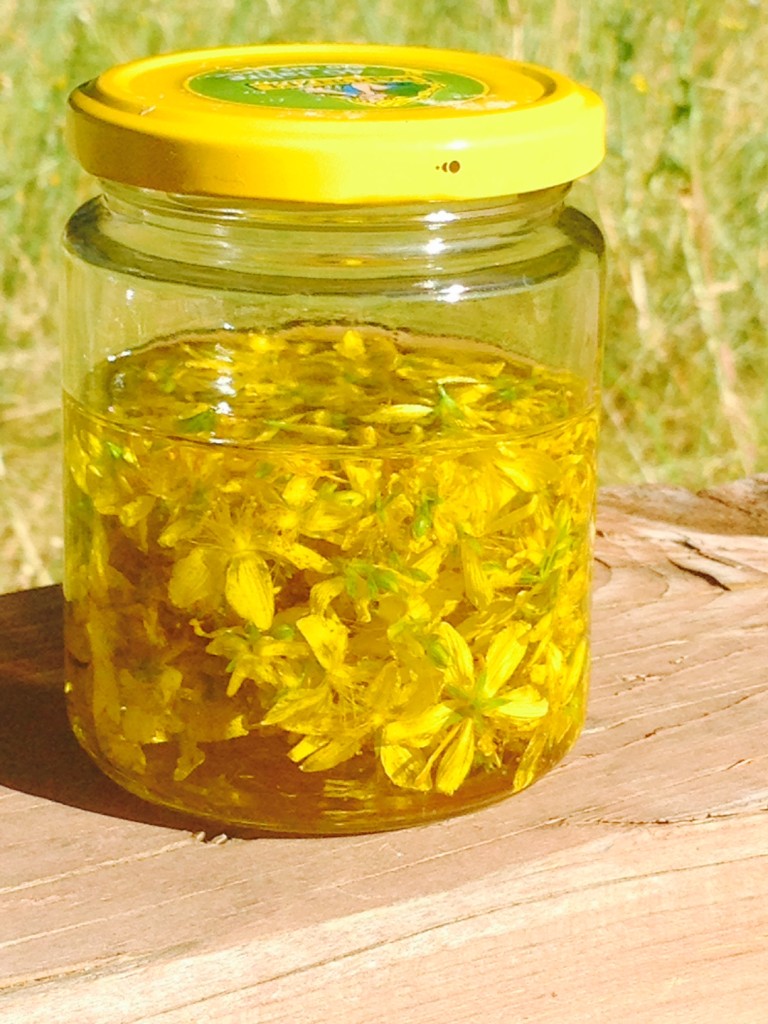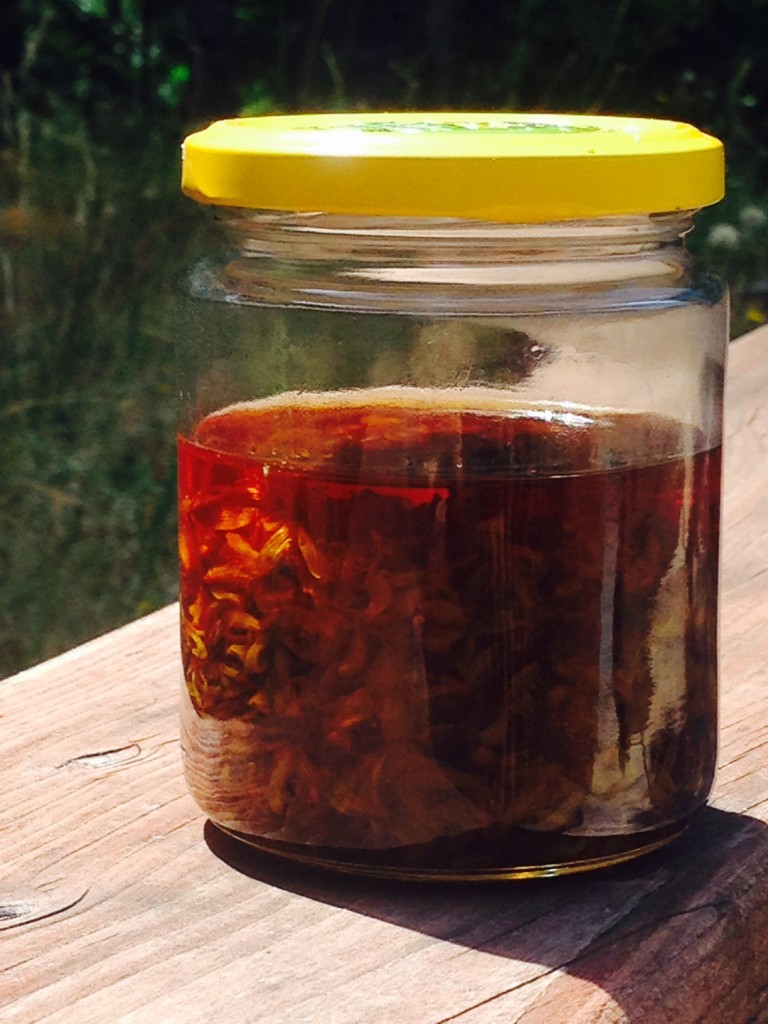
St John’s Wort is blooming all over the Cascade Range valleys right now and it’s the perfect time to harvest some of this medicinal powerhouse herb!
I harvest fresh St John’s Wort blossoms every year and make infused oil and tincture for use throughout the next year. My last post described a few of the medicinal uses of St John’s Wort.
Making infused medicinal oils is deceptively simple and amazingly useful. Here is a short and sweet tutorial of how to make St John’s Wort infused oil:
Ingredients:
- clean glass jar
- organic olive oil
- freshly picked and wilted St John’s Wort blossoms
 Harvest the blossoms (or flowering tops) of St John’s Wort and let them wilt for 6-24 hours. This allows some of the moisture to evaporate as well as any critters hiding in the petals to leave…
Harvest the blossoms (or flowering tops) of St John’s Wort and let them wilt for 6-24 hours. This allows some of the moisture to evaporate as well as any critters hiding in the petals to leave…
 Place in a clean glass jar leaving some headspace. Pour olive oil over the petals until the oil covers the herb about an inch.
Place in a clean glass jar leaving some headspace. Pour olive oil over the petals until the oil covers the herb about an inch.
 Place the lid on the jar tightly and set in a protected area in the sun, or a sunny windowsill for about 4 weeks. Open the lid every day or two and wipe out any condensation that forms.
Place the lid on the jar tightly and set in a protected area in the sun, or a sunny windowsill for about 4 weeks. Open the lid every day or two and wipe out any condensation that forms.
 Your oil will quickly turn blood red from the medicinal constituents of the herb infusing into the oil. After a month, you can strain out the herb and use the medicinal oil that is the result!
Your oil will quickly turn blood red from the medicinal constituents of the herb infusing into the oil. After a month, you can strain out the herb and use the medicinal oil that is the result!
I love using St John’s Wort infused oil straight as a massage oil, or sunburn remedy. But I also like to use it in blends to make healing salves of all kinds, as well as in lotion and moisturizer recipes.
Have you ever infused St John’s Wort in oil? What is your favorite way to use it?

I love the idea of using this as a sunburn remedy. Pinned. Amazing how it turns red due to the constituents. What a pretty flower, too. It’s interesting how often this flower shrub is used in landscaping parking lots! It’s so pretty and deserves to be in more home gardens. Thanks for the lovely, empowering post!
Thanks Megan. The variety that is used in landscaping is generally different than the variety used medicinally. Medicinally we use Hypericum perforatum. It grows wild in many areas of the US and worldwide 🙂
I grow this old time plant. It is an outstanding plant. The bees go crazy over it. I dry the flowers but should make a tincture with it.
I love to make fresh flower tinctures as well as oil infusions with St John’s Wort. You’re right, the bees do love it!
Hello, and thank you for your articles. Can you tell me if you can make a St John’s Wort oil if you buy it in bulk? I’ve seen a number of times people mentioning to use only fresh flowers. I live in San Diego and have not seen them here,…yet. Bottom line is I’d like to buy about 16 ounces of St John’s Wort from Mountain Rose Herbs and make a oil from it. Will that be effective ?
Thank you,
Brendon
Hi Brendon,
While it is ideal to use fresh flowering tops of the plant, I know that people do make infused oil with dried St John’s Wort. The consensus seems to be that it results in a weaker infusion and most likely, some of the constituents that we would like to see in the finished product would not be there. However, it is still useful and if it is your only option, you can certainly try it. Good luck!
Hi, Thanks for the teaching. My oil has barely turned red and it’s been sitting for over 2 weeks. Any ideas why?
Hi Megan! There could be several reasons why your oil is not turning red very fast. Some of the factors might include: did you use fresh or dry herb, how many hours a day is the jar in direct sunlight, did your carrier oil have a strong color to begin with, what variety of St john’s wort did you use?
I have had batches that turned redder than others, myself. Sometimes it just depends on the climate that year. My suggestion would be to give it another couple of weeks and make sure it sits in direct sunlight for 8 hours a day. Let me know how it turns out!
can i use dried flowers to make oil please. ?
Hi Marsey,
Depending on the herbal oil that you are wishing to create, you can sometimes use dried herbs to make a good quality oil. However, in the case of St John’s Wort infused oil, fresh flowers, or freshly wilted flowers, are preferred to achieve a high quality and effective finished product.
Thanks for the question!
I have mixed my St Johns Wort oil with a little lavender and aloe vera and used it as a burn remedy. Coincidentally I burned my hand badly not long after I made it and it really helped, I don’t even have a scar.
Hi there. We have tons of St John’s Wort growing all over our property in Quebec. I made a vodka based tincture with fresh flowers and it’s super red. I ready your direction for oil, dried the flowers for the recommended time and it’s been 2 days and not red at all. Then I read that everyone else suggests using fresh flowers and not drying at all. I’d love to know your thoughts. Thanks so much. Love learning about all of this.
Thanks for the question Deena. I don’t dry my flowers. As I mention in the post, I just wilt them for a day. This allows any critters to escape, as well as getting rid of excess moisture that might affect the finished product.
It takes a couple of weeks for the oils to turn red most of the time. It also depends on how much sun exposure the oil gets. During the years when it is super sunny here in the PNW, my oil becomes a much deeper red than the years when we have cloudy summers.
Is it safe to use on children and pregnant woman? Are there any precautions to topical use? Thank you 🙂
Hi Susie,
Yes, it is safe for use on pregnant women and children. There has been some concern about sun overexposure causing photosensitivity with large amounts of internal use of St John’s Wort. The jury is still out on that one. However, it has been traditionally used topically to prevent and treat sunburn. No contraindications topically.
Thanks for the question!
Can I use another oil instead of olive oil for a massage oil? Like avocado, jojoba, coconut, etc.?
Hi Margaret,
Yes, you can definitely use another oil. If I am making it strictly for topical use, I like to use jojoba for its stability. I prefer olive otherwise because many other oils have a shorter shelf life, but if you know you will use it up quickly, you can absolutely use a different oil.
Hi,
Just found your article and this recipe, which happens to have been used by my family for generations. It is a wonderful herb and a magical one:)! I wanted to add that this oil infusion can help also if you have stomach ulcers if taken by mouth. It helps for bad bed sores that are not healing, it helps with burns and minimizes or eliminates the scaring. It helps with all kinds of open wounds from scrapes to deep cuts.It is a wonderful medication.As I said it has been used in my family and my Grandmother and my Father, and now my Mom make it and gave it and give it generously to people who need it.Everyone who used it came back to say :Thank you! It helped!
Yes, I agree, it is a magical herb! Thanks for sharing Valentina.
Hi I live in south Alabama so I order my plant online. I followed the directions to the t and my oil is not turning red been in the windowsill for 4 weeks . Plus we have had a lot of cloudy and rainy days. It suggestions on what else I can do ?
It is true that cloudy, rainy weather can affect how the oil comes out. Alternatively, you can put the oil in a double boiler and heat it for a few hours, making sure that the oil doesn’t get so hot that it cooks the herbs. Good luck!
Im more interested in finding out if it will help in the healing of damaged nerves tothe dsouls of my feet and finger tips. I recently finished 6 months chemo treatment for bowel cancer ( folefox ) and by the end of the treatment my feet endrd up numb snd continue to get worse. I was told by a naturapath that st johns wart oil would heal the damaged nerves. Is this true . Rocketfox.
Thanks for the question. It is true that St John’s Wort is a specific for nerve damage. If it were me, I would try the infused oil topically, the tincture of St John’s Wort internally as well as the homeopathic remedy.
Bonjour from Québec !Thank you for the beautiful St-John’s Worth oil recepe ! Question; Can I use organic raw coconut oil instead of olive oil ?
Thank you ?
Danielle, yes, you can use coconut oil instead of olive oil. The only issue you may encounter is that unless the oil is warm, it will be in a solid state. For ease of use, I prefer oils that are in a liquid state at room temp.
Hello there. I have a different variety of St Johns Wort growing in my garden, it has large yellow blooms but instead of green stems it has purple/red stems. Does this variety also have medicinal properties?
Thanks so much.
Hi Hannah. There are well over 400 different varieties of St John’s Wort (Hypericum). I’m not sure which variety you have in your garden, but historically, the only variety that has been commonly used and researched medicinally is Hypericum perforatum.
Thank you very much for your informative post. I am currently making my SJW oil using extra virgin olive oil and the blossoms (with a little bit of green stalks); it is sitting out on my balcony. The weather has been perfect: 25-30 degrees and very little humidity. It has been sitting out for about 1.5 weeks but the colour is still green, so I have a couple of questions:
1. How soon is the oil supposed to turn red?
2. If the colour doesn’t turn ruby-red, does that mean the oil is no good? (there’s no bad smell or mould on the surface, and I stir it with a wooden spoon every day). Should I throw it out?
Hi Marina,
My oil usually starts to turn red in the first couple of weeks. However, there have been a few occasions when the weather was very cloudy or the St John’s Wort was too dry, and the oil never turned ruby red, just a pale orangish-red.
I would give your oil a couple more weeks in the heat of the sun and see what happens.
What is your method of wilting? I’ve had mine in my house For 4-6 hours uncovered. How long and how do you wilt yours? Thanks for all the info!
Trichelle,
I generally wilt my blossoms for 12-24 hrs, indoors, uncovered in a basket. Thanks for the question!
Hi
I love your website. It’s great to empower more people to make their own.
I first made this oil a couple of years ago and have been experimenting with it. I also find that it’s amazing for muscular aches and pains. It’s now my husband’s turn to remedy for achy muscles. So, it seems it a pretty versatile herb!
Hi Nikki.
You are absolutely correct! St John’s Wort has many uses and is excellent for aching muscles. Thanks for the comment.